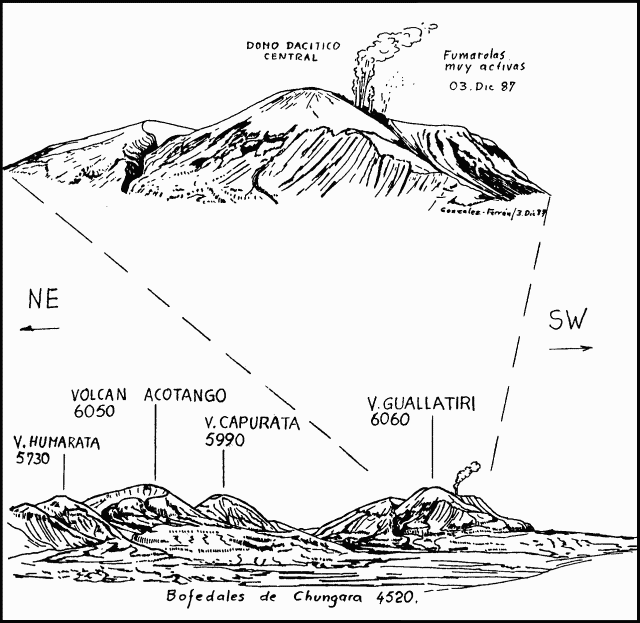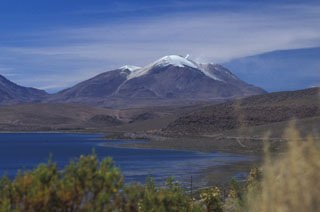Report on Guallatiri (Chile) — December 1987
Scientific Event Alert Network Bulletin, vol. 12, no. 12 (December 1987)
Managing Editor: Lindsay McClelland.
Guallatiri (Chile) Increased fumarolic activity; distant 1985 observation probably of this volcano
Please cite this report as:
Global Volcanism Program, 1987. Report on Guallatiri (Chile) (McClelland, L., ed.). Scientific Event Alert Network Bulletin, 12:12. Smithsonian Institution. https://doi.org/10.5479/si.GVP.SEAN198712-355020
Guallatiri
Chile
18.42°S, 69.092°W; summit elev. 6071 m
All times are local (unless otherwise noted)
"During a reconaissance in the Nevados de Pachayata/Nevados de Quimsachata region between 2 and 5 December, vigorous fumarolic activity was observed at Guallatiri. The activity was much more intense than in previous years and the emissions were more frequent, occurring about every 30 minutes. Whitish-yellow columns rose 300-500 m above the volcano's central dacitic dome. Nearby secondary fumaroles extended from the principal vent onto the W part of the volcano (figure 2).
 |
Figure 2. Sketch map of Guallatiri showing fumaroles active on 3 December 1987. Courtesy of O. González-Ferrán. |
"In December 1985, Robert Koeppen had observed (from the base of Sajama volcano 25 km to the NE) strong fumaroles that appeared to be from Acotango. During the 1987 reconaissance, the volcanoes Capurata, Acotango, and Humarata did not show any signs of activity; their craters were covered with ice and clean snow. Consequently, we believe that the activity observed by Koeppen was not from Acotango, but from Guallatiri [farther along Koeppen's line of sight from Sajama; see map in 10:11], which recently has notably increased its activity."
Geological Summary. One of northern Chile's most active volcanoes, Volcán Guallatiri is a symmetrical ice-clad stratovolcano at the SW end of the Nevados de Quimsachata volcano group. It lies just W of the border with Bolivia and is capped by a central dacitic dome or lava complex, with the active vent situated on its S side. Thick lava flows are prominent on the lower N and W flanks of the andesitic-to-rhyolitic volcano. Minor explosive eruptions have been reported since the beginning of the 19th century. Intense fumarolic activity with "jet-like" noises continues, and numerous solfataras extend more than 300 m down the W flank.
Information Contacts: O. González-Ferrán, Univ de Chile.

